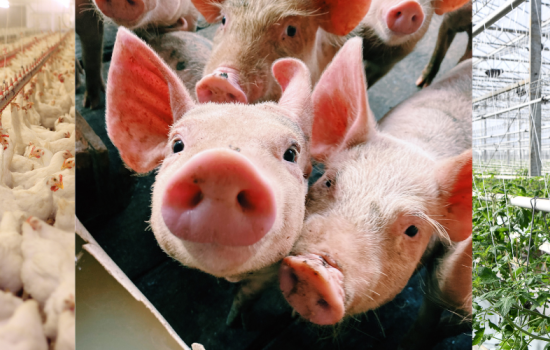When electricity services to farms or nurseries are installed or altered (e.g. supply capacity is increased or a single-phase supply is converted to three phase), there are usually major costs incurred in reinforcing or re-engineering the supply network. As the customer, you are usually asked to pay for all or part of this work.
In today’s privatised and competitive energy market all the components of supply are separate and up to four different companies may be involved.
Your electricity grid connection is organised by your Distribution Network Operator (DNO) and you may use an additional Independent Connections Provider (ICP) for some of the connection works. Then there is your electricity supplier and, finally, the organisation that looks after your metering.
So, it can also be a bit of a minefield if you are unaware of who is responsible for what and how it all fits together.
In this guide, we aim to explain, demystify and ease the process and give you some practical pointers to achieve a successful outcome.
Getting started
If you are planning a new energy project, you are likely to have various advisors and suppliers involved in your development. You must be clear from the outset who is responsible for the grid connection element – it’s easy for this to get overlooked or receive too little attention and it’s a mistake to think it will be a quick and simple matter to address later on. You may be lucky enough to be working with a developer who is used to managing grid connections. If not, consider using a specialist energy advisor.
Planning your project
Consider the positioning of your project in relation to the accessibility of the electricity supply and how it will integrate with the rest of the development.
You want to minimise the need for expensive additional cabling (likely to be around £60-70 per metre), high voltage cables and transformers. Renewable generation projects in particular, especially if on a remote site, can involve extensive works.
Something as simple as choosing one end of a field over another can often significantly affect payback or even make or break a project. So it’s important when choosing a site location to be sure to fully evaluate grid connection options as well as the most obvious aspects of access and planning.
In addition, think about your relationships with those who own the land around your chosen site. If you have to route lines across someone else’s field, you will have to apply for a wayleave. If the landowner refuses to grant a wayleave, then you will have to re-route – and greater distances will mean greater costs.
These aspects take a relatively short time to assess and can make a big difference to costs and therefore project viability.
The process of applying for an increased electricity supply
We recommend you take the following steps when considering an application for an electricity connection:
- Make a list of the new equipment you propose to install, e.g. two l0 kW pumps, or an extra eight 630 mm fans, 400 W each. Consider that, in sizing the connection, the electricity company is interested in the sustained electrical demand over any single V2 hour period. This must take into account your existing load plus the new load. This is seldom obtained by simply adding together the ratings of all the equipment, as there is always some 'diversity' in use. For instance, in a house, an electric shower, a kettle and an oven would V2 hour demand not be on full, together for any one complete 112 hour period. The actual would be considerably less than the sum of the three ratings Judging this, especially for large installations, can be tricky so you advised to consult someone who has experience in this practice.
- You also need to know the largest motor and welder size and the 'starting' method it uses. This is because these types of equipment demand large amounts of current when starting or striking and as a result, cause the voltage to 'flicker’. It's always best to limit equipment size if possible (i.e. use two small motors instead of one large one) or use low disturbance starting methods like ‘soft-start’.
- Contact your DNO for an 'Application for New Supply' form. Note that your DNO may be a company with a name not familiar to you – E.g. Western Power Distribution, UK Power Networks, Northern Power Grid. These companies are not involved in energy sales so do not have the high profile of companies like Npower or E-ON. However, they are responsible for the electricity network and connections. Your electricity supplier may be able to help you in contacting your DNO.
- Most DNOs will give you an initial estimate for the cost of work required. Don't be put off by the figure quoted. For some reason, early estimates are often wildly high.
- For a full quotation, you may be asked to pay a 'design fee' up front, and if you should subsequently decide not to proceed in having the scheme installed, you will lose this money.
- Remember that clear proposals will lead to speedier answers. Try not to be vague about what you want and provide detail plans of where you want the supply to be connected and any routes you think are preferable.
- If you have equipment available to carry out excavation and reinstatement, you may be able to save money by opting to do this work yourself.
- Remember that supply reinforcements involving alteration or extensions of the high voltage network can take 6 to 12 months to complete, so it is essential to inform your DNO as soon as you start to plan any new development. Don't wait till everything else is built before applying.
- Consider future possible expansion plans at the same time as your present proposal. Although it's not wise to oversize your requirements, it’s worth taking into account your future plans so you don't have to do the job twice.
- You may be asked to complete a site hazard form which asks questions about possible ground contamination, working hazards and other contractors working on the site.
- Many DNOs ask for their money upfront well before they undertake the work. Sometimes, especially when wayleave negotiations are protracted, you can negotiate to pay an initial deposit with the balance due before to construction work starts.
- If you accept a quotation from a DNO for new work you will be asked to nominate an 'Electricity Supplier' who will be responsible for organising your meter and your electricity contract. If you fail to do this, you will not be able to be connected when the network installation is finished.
Breakdown of times required for the stages in a typical installation
- Technical proposals and quotation - 1 to 3 months.
- Wayleaves and easements - 2 months.
- Local Planning Authority - 6 weeks.
- Department of Energy - 2 weeks.
- Work programming - 1 to 6 months.
How to bring costs down
A frequently asked question is, “Could any party other than my DNO undertake the work at a lower cost?" Although your DNO will provide you with a full quotation for the complete works, you can use an Independent Connection Provider (ICP) for what is termed the “contestable” part of the works.
The “non-contestable” works are those that the DNO must undertake but the rest is classed as “contestable”, that is available to another provider. Using an ICP for this “contestable” part can save up to 40% on the DNO’s total quote.
Other advantages include shorter quotation lead times, shorter work completion time and staged payments.
If you want to consider using an ICP, be aware that you have to specifically apply for a ‘point of connection’ quotation in order to obtain details of this split – it is not given by the DNO as a matter of course.
You can find an ICP by searching the Lloyds Register which lists suppliers accredited under the National Electricity Registration Scheme.
Disputes
If you receive a quotation you are not happy with it, you should firstly query it with your DNO. You can take this further if necessary with your local Consumer Focus office. Finally, it is possible to take a dispute to 'determination' which is judged by Ofgem and produces a binding result. This process can be involved and lengthy.
In summary
Getting connected can be tricky and time consuming. It includes lining up contracts for supply and metering as well as dealing with the physical connection – all of which means negotiating with and managing several different players.
Export connections for generators can be more complex and expensive than import connections. Quite modest generation capacities can involve extensive works and you also need to consider issues like Feed-in Tariffs, power purchase agreements and export metering.
The onus is on you to ask for the right thing. Get started as early as possible and seek professional advice where necessary.
Useful contacts
Energy Networks Association (ENA), 6th Floor, Dean Bradley House, 52 Horseferry Road, London, SW1P 2AF
Telephone: 020 7706 5100
www.energynetworks.org
ENA represents the transmission and distribution network operators for gas and electricity in the UK and Ireland. Membership is open to all owners and operators of energy networks in the UK.
Ofgem, 9 Millbank, London, SW1P 3GE
Telephone: 020 7901 7000
www.ofgem.gov.uk
Ofgem is the Office of the Gas and Electricity Markets, which supports the Gas and Electricity Markets Authority, the regulator of the gas and electricity industries in Great Britain.
Consumer Focus, Fleetbank House, Salisbury Square, London, EC4Y 8JX
Telephone: 020 7799 7900
www.consumerfocus.org.uk
Consumer Focus is the statutory consumer champion for England, Wales, Scotland and (for postal consumers) Northern Ireland. Part of its remit is securing a fair deal for energy consumers and it was formed from the merger of energywatch and postwatch in 2008.
Glossary
DNO – Distribution Network Operator
The owner and operator of the network of towers and cables that bring electricity from the National Transmission Network to your business.
ICP - Independent Connections Provider
An accredited company that is entitled to build electricity networks to the specification and quality required for them to be subsequently owned by the relevant DNO.
Electricity supplier
The company that supplies and sells you your electricity.
Meter operator
The company that installs and looks after your electricity meter and measures your electricity usage.




